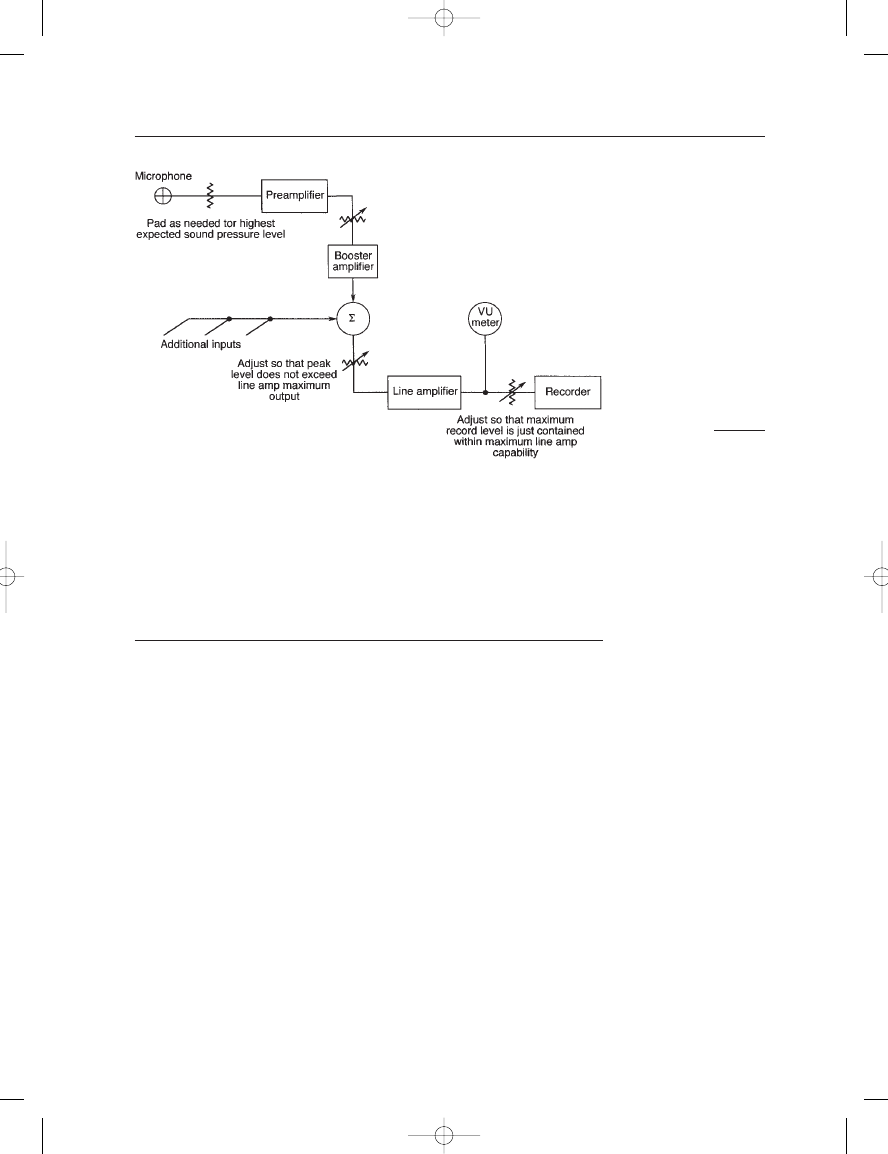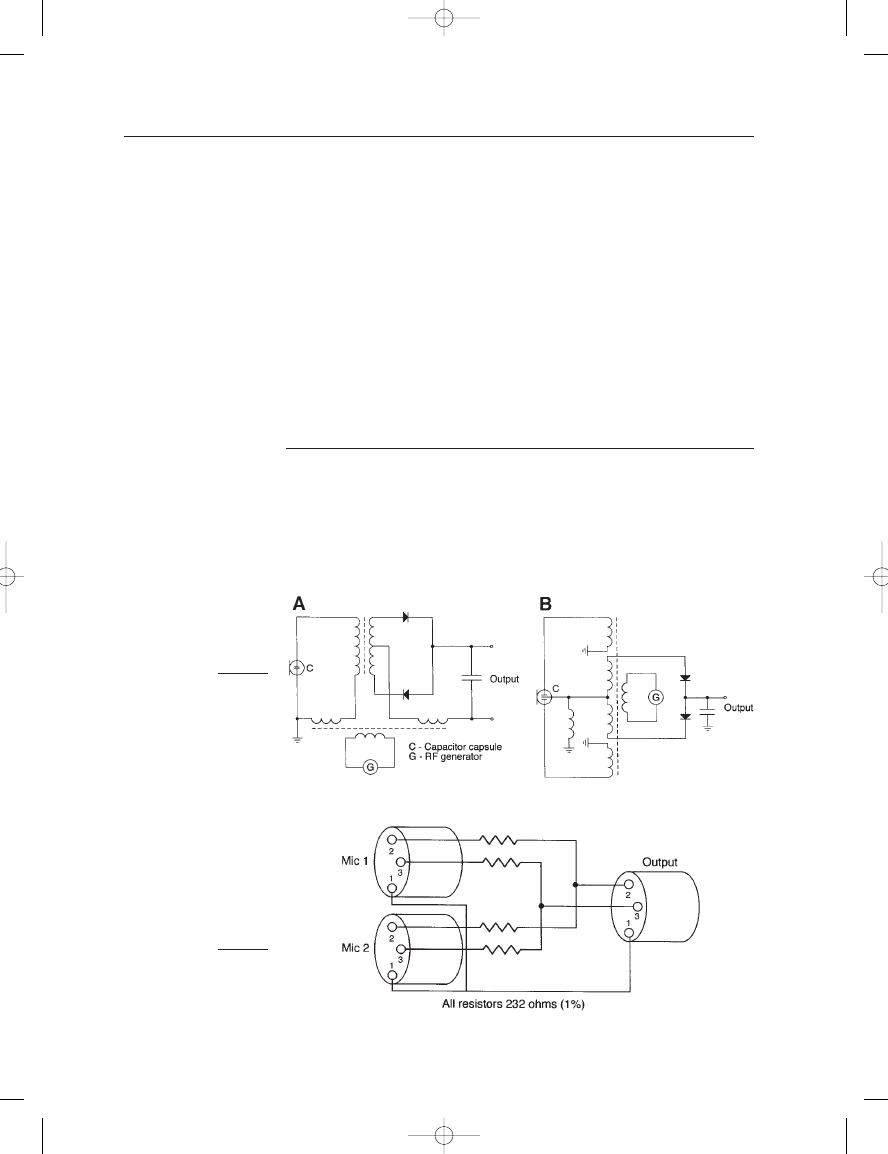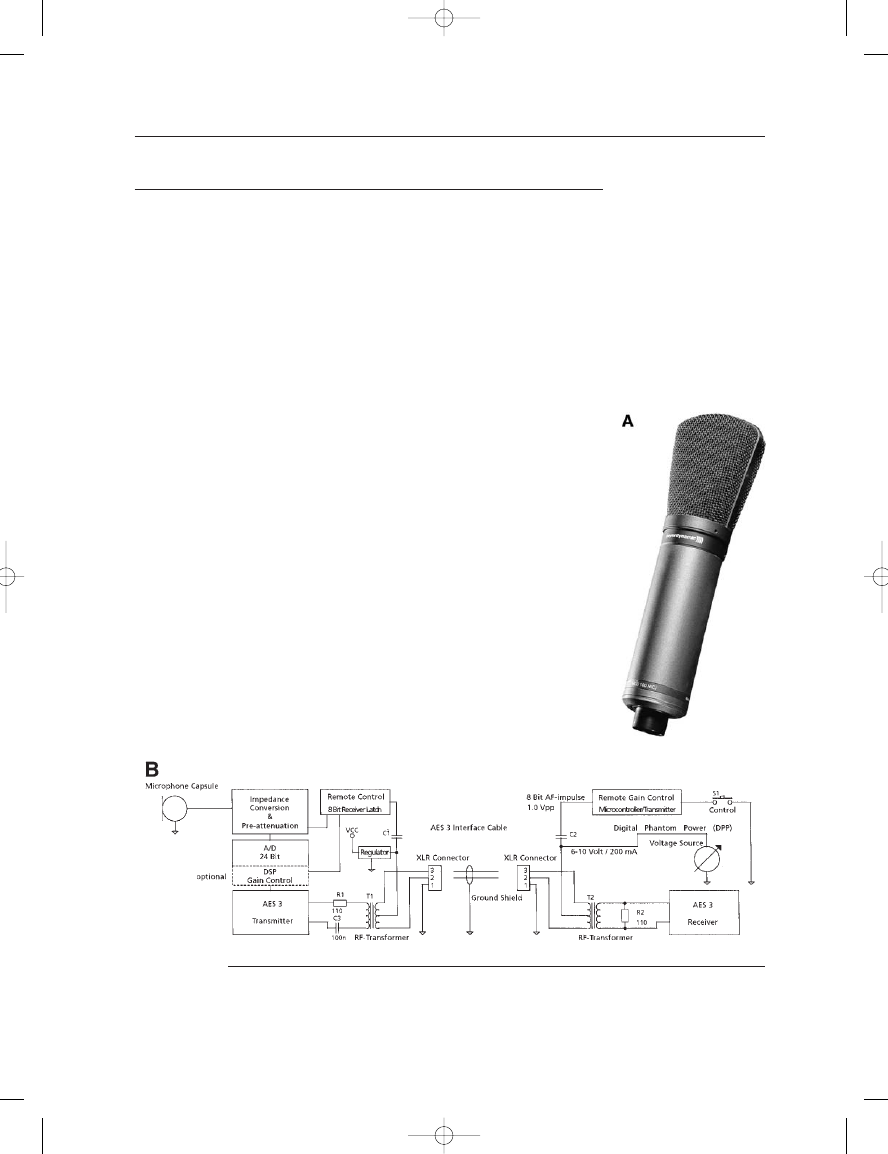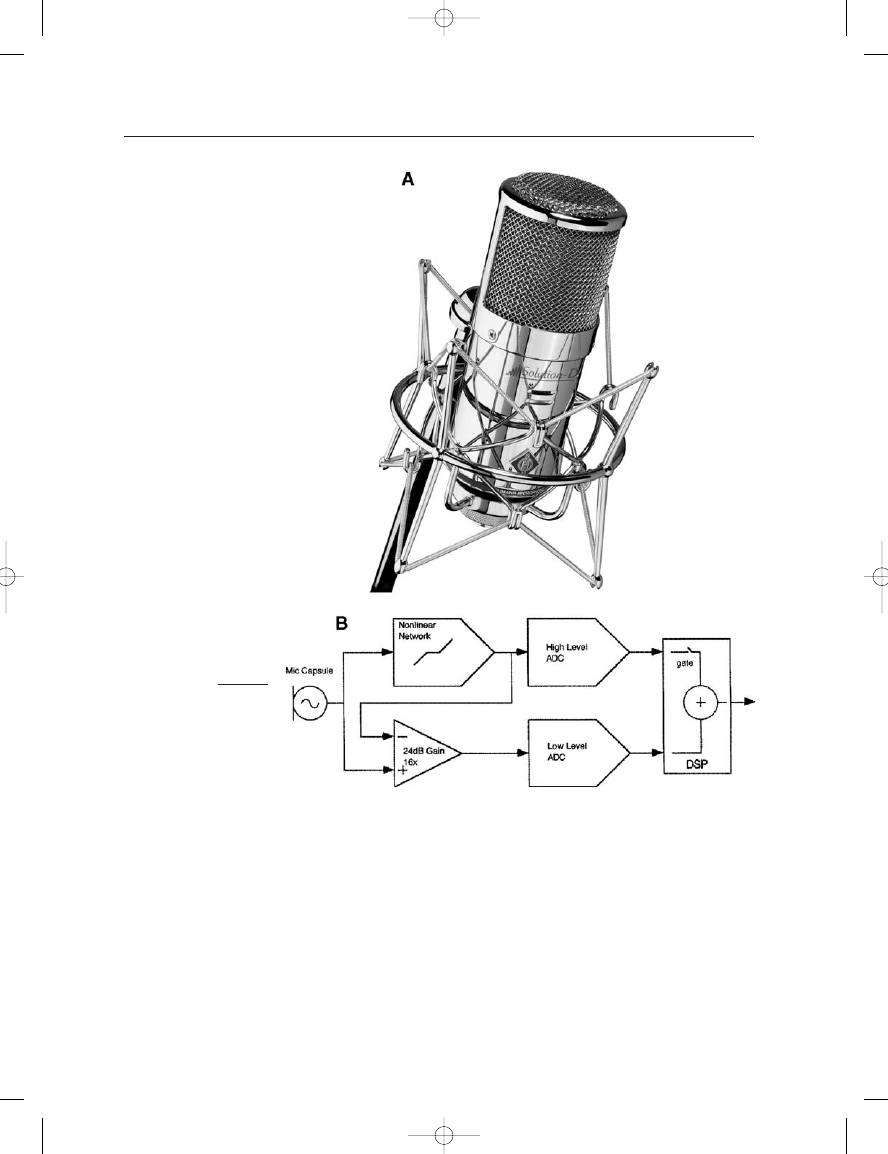ВУЗ: Казахская Национальная Академия Искусств им. Т. Жургенова
Категория: Книга
Дисциплина: Не указана
Добавлен: 03.02.2019
Просмотров: 17286
Скачиваний: 51

Recording engineers engaged in direct-to-stereo recording, or in
making stereo mixes from multitrack tapes, must be aware of the process
discussed here.
MICROPHONES USING THE RF (RADIO FREQUENCY)
TRANSMISSION PRINCIPLE
The capacitor microphone discussed in Chapter 3 operates on the principle
of variable capacitance with fixed charge producing a variable signal out-
put voltage. There is another method of deriving a signal from variable
capacitance that has been successfully used by only a few microphone
manufacturers, and that is the RF transmission principle. Today, only
the Sennheiser company of Germany manufacturers such microphones on
a large scale.
The RF capacitor microphone has exactly the same acoustical charac-
teristics as a dc polarized microphone of the same physical geometry. The
only difference is the method of converting the capacitance variations into
a signal output.
Hibbing (1994) gives a complete account of the history and analysis
of RF microphones. He describes two general methods, and simplified
circuits for each are shown in Figure 8–26. The circuit shown at A works
on the phase modulation (PM) principle and as such resembles a small
FM transmitter-receiver combination in a single microphone package.
The variable capacitance alters the tuning of a resonant circuit; adjacent
to the tuned circuit are a discriminator section and a fixed oscillator oper-
ating in the range of 8 MHz. All three sections are mutually coupled
through RF transformers. The alternations of tuning resulting from audio
THE MICROPHONE BOOK
138
FIGURE 8–25
Combining multiple inputs.
Earg_08.qxd 14/9/04 2:45 PM Page 138

pressure variations affect the balance of upper and lower sections of the
discriminator, and an audio signal output is present at the output.
Circuit details of the AM bridge design are shown in Figure 8–26B.
Here, a dual-backplate push-pull diaphragm is used to advantage as a
push-pull voltage divider, distributing the RF signal equally to both sides
of the bridge circuit when in its rest position. Under audio excitation, the
bridge output will be proportional to diaphragm excursion, providing a
high degree of linearity. It is this modulation principle that is used in the
Sennheiser MKH-20 series of studio microphones.
Early RF microphones were prone to internal instability and on
occasion interference from local radio transmissions. Over the years the
art has literally “fine-tuned” itself, and the modern Sennheiser MKH-
series microphones are superb performers in all respects.
PARALLEL OPERATION OF MICROPHONES
While not generally recommended, it is possible to operate two micro-
phones at a single console input if phantom power is not required.
The price paid for this is a reduction in level of about 6 dB for each
microphone and of course the inability to adjust levels individually. The
circuit shown in Figure 8–27 shows how this can be done.
8: Electrical Considerations and Electronic Interface
139
FIGURE 8–26
RF microphones;
simplified circuit for phase
modulation system (A);
simplified circuit for
balanced bridge operation
(B). (Data after Sennheiser.)
FIGURE 8–27
A circuit for paralleling the
output of two microphones.
(Data after Shure Inc.)
Earg_08.qxd 14/9/04 2:45 PM Page 139

DIGITAL MICROPHONES
So-called digital microphones have entered the marketplace during
the last six or so years. Strictly speaking, these models are not actually
“digital” in the specific sense of directly generating a digital output code
from the diaphragm. Rather, they make use of traditional dc bias and
preamplification of the analog signal at the diaphragm. It is only after
this stage that analog-to-digital conversion takes place.
The advantage of these microphones is that certain problems in dig-
ital processing can be dealt with earlier, rather than later, in the audio
chain. For example, the useful signal-to-noise ratio of a well-designed
25 mm (1 in) condenser diaphragm can be in the range of about 125 to
135 dB. An ideal 20-bit system is capable of a signal-to-noise range
of 120 dB, and in a traditional recording system this will require trunca-
tion of the available dynamic range of the microphone by about 10 dB.
In and of itself, this may or may not be a problem, depending on other
electrical and acoustical considerations in the actual studio environment.
In the beyerdynamic model MCD100 series, the capsule looks into a
22-bit conversion system directly when the acoustical level is high (greater
than 124 dB L
P
). For normal studio levels (less than about 100 dB L
P
), –10
or –20 dB padding can be inserted ahead of the digital conversion stage in
order to optimize the bit depth. Sophisticated level control prevents the
system from going into digital clipping. The microphone and associated
signal flow diagram is shown in Figure 8–28A and B.
The Neumann Solution-D uses two 24-bit A-to-D converters oper-
ating in parallel and offset by 24 dB. These two digital signals are seam-
lessly recombined in the digital domain to produce a single digital output
signal with a net resolution of 28 bits (Monforte, 2001). Figure 8–29A
shows a view of the Solution-D microphone, and a signal flow diagram
is shown at B.
THE MICROPHONE BOOK
140
FIGURE 8–28
Details of beyerdynamic digital microphone system: view of microphone (A); signal flow diagram (B). (Data courtesy of
beyerdynamic.)
Earg_08.qxd 14/9/04 2:45 PM Page 140

Both of these microphone systems have additional digital features,
including variable sampling rates, various interface formats, some degree
of built-in digital signal processing, and the ability to respond to certain
user commands via the digital bus. The Audio Engineering Society (AES)
is actively pursuing interface standards for this new class of products.
8: Electrical Considerations and Electronic Interface
141
FIGURE 8–29
Details of Neumann
Solution-D digital
microphone system: view of
microphone (A); signal flow
diagram (B). (Data courtesy
of Neumann/ USA.)
Earg_08.qxd 14/9/04 2:45 PM Page 141

C
H
A
P
T
E
R
9
OVERVIEW OF WIRELESS
MICROPHONE TECHNOLOGY
INTRODUCTION
Outside of recording and broadcast studios, the wireless microphone is
virtually indispensable. The technology dates back to the 1960s, and
great strides in performance quality and overall reliability have been
made since that time. Television, staged music and drama performances,
religious services, and public meetings all make use of wireless micro-
phones; and the ultimate freedom of movement offered by the technology
is seen as a boon by everyone involved in live performance.
The earliest wireless microphones employed the commercial FM
(frequency modulation) band at very low output power, and consumer FM
tuners were used for signal recovery. In time, the Federal Communications
Commission (FCC) allocated specific frequency bands in the VHF and
UHF television ranges for wireless microphones as well as for other short-
range communications needs. Today, virtually all major microphone
manufacturers offer wireless systems, and the user has much to choose
from. Most of these manufacturers have published detailed user guides
that cover both technical matters as well as usage recommendations.
In this chapter we discuss in detail the technology involved in wireless
microphone design and its application in a number of performance areas.
CURRENT TECHNOLOGY
FREQUENCY ALLOCATION
Wireless microphones can be licensed for operation in the following
radio frequency (RF) ranges:
1. VHF (very-high frequency) range:
Low band: 49–108 MHz
High band: 169–216 MHz
Earg_09.qxd 14/9/04 2:46 PM Page 142